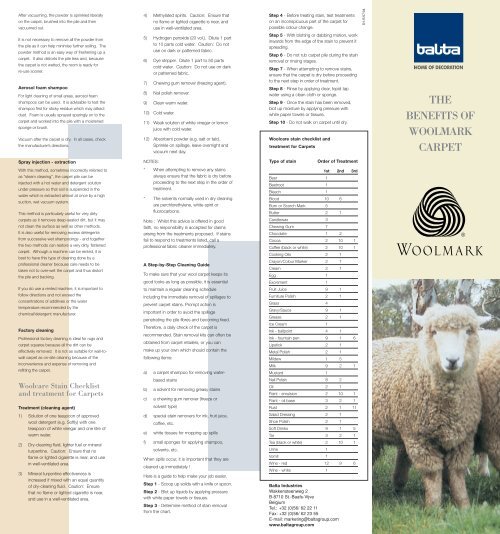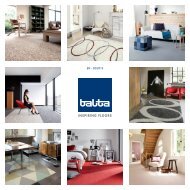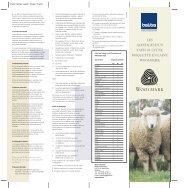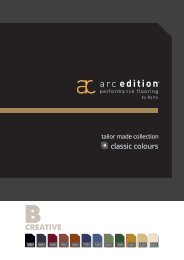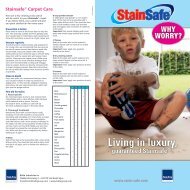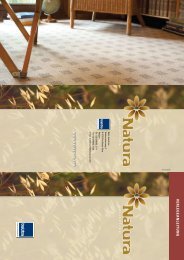THE BENEFITS OF WOOLMARK CARPET - Balta Group
THE BENEFITS OF WOOLMARK CARPET - Balta Group
THE BENEFITS OF WOOLMARK CARPET - Balta Group
You also want an ePaper? Increase the reach of your titles
YUMPU automatically turns print PDFs into web optimized ePapers that Google loves.
After vacuuming, the powder is sprinkled liberally<br />
on the carpet, brushed into the pile and then<br />
vacuumed out.<br />
4) Methylated spirits. Caution: Ensure that<br />
no flame or lighted cigarette is near, and<br />
use in well-ventilated area.<br />
Step 4 - Before treating stain, test treatments<br />
on an inconspicuous part of the carpet for<br />
possible colour change.<br />
S/1/E/07/04<br />
It is not necessary to remove all the powder from<br />
the pile as it can help minimise further soiling. The<br />
powder method is an easy way of freshening up a<br />
carpet. It also distorts the pile less and, because<br />
the carpet is not wetted, the room is ready for<br />
re-use sooner.<br />
Aerosol foam shampoo<br />
For light cleaning of small areas, aerosol foam<br />
shampoos can be used. It is advisable to test the<br />
shampoo first for sticky residue which may attract<br />
dust. Foam is usually sprayed sparingly on to the<br />
carpet and worked into the pile with a moistened<br />
sponge or brush.<br />
Vacuum after the carpet is dry. In all cases, check<br />
the manufacturer’s directions.<br />
5) Hydrogen peroxide (20 vol.). Dilute 1 part<br />
to 10 parts cold water. Caution: Do not<br />
use on dark or patterned fabric.<br />
6) Dye stripper. Dilute 1 part to 50 parts<br />
cold water. Caution: Do not use on dark<br />
or patterned fabric.<br />
7) Chewing gum remover (freezing agent).<br />
8) Nail polish remover.<br />
9) Clean warm water.<br />
10) Cold water.<br />
11) Weak solution of white vinegar or lemon<br />
juice with cold water.<br />
12) Absorbent powder (e.g. salt or talc).<br />
Sprinkle on spillage, leave overnight and<br />
vacuum next day.<br />
Step 5 - With blotting or dabbing motion, work<br />
inwards from the edge of the stain to prevent it<br />
spreading.<br />
Step 6 - Do not rub carpet pile during the stain<br />
removal or rinsing stages.<br />
Step 7 - When attempting to remove stains,<br />
ensure that the carpet is dry before proceeding<br />
to the next step in order of treatment.<br />
Step 8 - Rinse by applying clear, tepid tap<br />
water using a clean cloth or sponge.<br />
Step 9 - Once the stain has been removed,<br />
blot up moisture by applying pressure with<br />
white paper towels or tissues.<br />
Step 10 - Do not walk on carpet until dry.<br />
Woolcare stain checklist and<br />
treatment for Carpets<br />
<strong>THE</strong><br />
<strong>BENEFITS</strong> <strong>OF</strong><br />
<strong>WOOLMARK</strong><br />
<strong>CARPET</strong><br />
Spray injection - extraction<br />
NOTES:<br />
Type of stain<br />
Order of Treatment<br />
With this method, sometimes incorrectly referred to<br />
as “steam cleaning”, the carpet pile can be<br />
injected with a hot water and detergent solution<br />
under pressure so that soil is suspended in the<br />
water which is extracted almost at once by a high<br />
suction, wet vacuum system.<br />
This method is particularly useful for very dirty<br />
carpets as it removes deep-seated dirt, but it may<br />
not clean the surface as well as other methods.<br />
It is also useful for removing excess detergents<br />
from successive wet shampooings - and together<br />
the two methods can restore a very dirty, flattened<br />
carpet. Although a machine can be rented, it is<br />
best to have this type of cleaning done by a<br />
professional cleaner because care needs to be<br />
taken not to over-wet the carpet and thus distort<br />
the pile and backing.<br />
If you do use a rented machine, it is important to<br />
follow directions and not exceed the<br />
concentrations of additives or the water<br />
temperature recommended by the<br />
chemical/detergent manufacturer.<br />
Factory cleaning<br />
Professional factory cleaning is ideal for rugs and<br />
carpet squares because all the dirt can be<br />
effectively removed. It is not as suitable for wall-towall<br />
carpet as on-site cleaning because of the<br />
inconvenience and expense of removing and<br />
refitting the carpet.<br />
* When attempting to remove any stains<br />
always ensure that the fabric is dry before<br />
proceeding to the next step in the order of<br />
treatment.<br />
* The solvents normally used in dry cleaning<br />
are perchlorethylene, white spirit or<br />
fluorocarbons.<br />
Note : Whilst this advice is offered in good<br />
faith, no responsibility is accepted for claims<br />
arising from the treatments proposed. If stains<br />
fail to respond to treatments listed, call a<br />
professional fabric cleaner immediately.<br />
A Step-by-Step Cleaning Guide<br />
To make sure that your wool carpet keeps its<br />
good looks as long as possible, it is essential<br />
to maintain a regular cleaning schedule<br />
including the immediate removal of spillages to<br />
prevent carpet stains. Prompt action is<br />
important in order to avoid the spillage<br />
penetrating the pile fibres and becoming fixed.<br />
Therefore, a daily check of the carpet is<br />
recommended. Stain removal kits can often be<br />
obtained from carpet retailers, or you can<br />
make up your own which should contain the<br />
following items:<br />
a) a carpet shampoo for removing water-<br />
Beer<br />
Beetroot<br />
Bleach<br />
Blood<br />
Burn or Scorch Mark<br />
Butter<br />
Candlewax<br />
Chewing Gum<br />
Chocolate<br />
Cocoa<br />
Coffee (black or white)<br />
Cooking Oils<br />
Crayon/Colour Marker<br />
Cream<br />
Egg<br />
Excrement<br />
Fruit Juice<br />
Furniture Polish<br />
Grass<br />
Gravy/Sauce<br />
Grease<br />
Ice Cream<br />
Ink - ballpoint<br />
Ink - fountain pen<br />
Lipstick<br />
Metal Polish<br />
Mildew<br />
Milk<br />
Mustard<br />
1st<br />
1<br />
1<br />
1<br />
10<br />
5<br />
2<br />
3<br />
7<br />
1<br />
2<br />
2<br />
2<br />
2<br />
2<br />
1<br />
1<br />
9<br />
2<br />
4<br />
9<br />
2<br />
1<br />
4<br />
9<br />
2<br />
2<br />
1<br />
9<br />
1<br />
2nd<br />
6<br />
1<br />
2<br />
10<br />
10<br />
1<br />
1<br />
1<br />
1<br />
1<br />
1<br />
1<br />
1<br />
1<br />
1<br />
1<br />
5<br />
2<br />
3rd<br />
1<br />
1<br />
6<br />
1<br />
®<br />
PURE NEW WOOL<br />
Woolcare Stain Checklist<br />
and treatment for Carpets<br />
Treatment (cleaning agent)<br />
based stains<br />
b) a solvent for removing greasy stains<br />
c) a chewing gum remover (freeze or<br />
solvent type)<br />
Nail Polish<br />
Oil<br />
Paint - emulsion<br />
Paint - oil base<br />
Rust<br />
8<br />
2<br />
2<br />
3<br />
2<br />
2<br />
1<br />
10<br />
2<br />
1<br />
1<br />
1<br />
11<br />
1) Solution of one teaspoon of approved<br />
wool detergent (e.g. Softly) with one<br />
teaspoon of white vinegar and one litre of<br />
warm water.<br />
2) Dry-cleaning fluid, lighter fuel or mineral<br />
turpentine. Caution: Ensure that no<br />
flame or lighted cigarette is near, and use<br />
in well-ventilated area.<br />
3) Mineral turpentine effectiveness is<br />
increased if mixed with an equal quantity<br />
of dry-cleaning fluid. Caution: Ensure<br />
that no flame or lighted cigarette is near,<br />
and use in a well-ventilated area.<br />
d) special stain removers for ink, fruit juice,<br />
coffee, etc.<br />
e) white tissues for mopping up spills<br />
f) small sponges for applying shampoo,<br />
solvents, etc.<br />
When spills occur, it is important that they are<br />
cleaned up immediately !<br />
Here is a guide to help make your job easier.<br />
Step 1 - Scoop up solids with a knife or spoon.<br />
Step 2 - Blot up liquids by applying pressure<br />
with white paper towels or tissues.<br />
Step 3 - Determine method of stain removal<br />
from the chart.<br />
Salad Dressing<br />
Shoe Polish<br />
Soft Drinks<br />
Tar<br />
Tea (black or white)<br />
Urine<br />
Vomit<br />
Wine - red<br />
Wine - white<br />
2<br />
2<br />
9<br />
3<br />
2<br />
1<br />
1<br />
12<br />
1<br />
<strong>Balta</strong> Industries<br />
Wakkensteenweg 2<br />
B-8710 St.-Baafs-Vijve<br />
Belgium<br />
Tel.: +32 (0)56/ 62 22 11<br />
Fax: +32 (0)56/ 62 23 55<br />
E-mail: marketing@baltagroup.com<br />
www.baltagroup.com<br />
1<br />
1<br />
1<br />
2<br />
10<br />
9<br />
5<br />
1<br />
1<br />
6
The Benefits of<br />
Woolmark and<br />
Woolblendmark Carpet<br />
The Woolmark and the<br />
Woolblendmark are two of the<br />
world’s most recognised textile<br />
symbols and represent your<br />
assurance of the finest quality<br />
and reliability.<br />
Only approved companies are<br />
licensed to use these marks in<br />
association with their products.<br />
Carpets bearing these marks must<br />
pass a stringent set of tests for<br />
quality and performance, to comply<br />
with technical standards prescribed<br />
by The Woolmark Company.<br />
The Benefits of Wool<br />
How do I recognise a quality carpet<br />
Look for Woolmark and Woolblendmark labelled<br />
carpets as they are quality assured, having been<br />
subject to The Woolmark Company’s 24 stringent<br />
performance tests. A Woolmark or<br />
Woolblendmark carpet will be a part of your life for<br />
years to come.<br />
Why choose wool<br />
Wool has been used for centuries and its<br />
performance capabilities are well known. Its major<br />
attributes include a natural resistance to soiling,<br />
staining and flames. Wool has very good<br />
appearance, retention and durability properties<br />
because of its natural resiliency, resistance to static<br />
build up and its ease of cleaning and maintenance.<br />
What is the difference between<br />
wool and synthetic fibres<br />
Wool is a natural product whilst synthetics are<br />
manufactured from man-made chemicals. Wool is<br />
considered to be the superior fibre for high quality<br />
domestic and commercial installations. It is also<br />
biodegradable and a renewable resource.<br />
What about mixes of wool and<br />
Is it necessary to use the same<br />
carpet throughout the house<br />
No. It is not necessary to use the same carpet<br />
throughout the house and you may choose<br />
different carpet grades for different areas. If it is<br />
desirable to use the same carpet throughout and<br />
your chosen carpet is not available in different<br />
grades, choose a carpet grade according to the<br />
heaviest traffic area.<br />
What is a Woolmark carpet’s<br />
life expectancy<br />
Subject to the correct grade being selected, it<br />
depends on how well the carpet is looked after,<br />
maintained and how much wear it gets. With care,<br />
it is possible for a Woolmark carpet to last a<br />
decade or more.<br />
Is Pure New Wool a problem for<br />
allergy sufferers<br />
The Pure New Wool fibre component in products<br />
has not been known to cause allergic reactions.<br />
If you are concerned about potential allergic<br />
reactions to new carpet, check with your<br />
medical practitioner for correct diagnosis<br />
regarding allergies.<br />
Do Woolmark carpets need to be stain<br />
resist treated<br />
Pure New Wool carpet has long been<br />
acknowledged for its unique natural ability to resist<br />
dirt, stains and spills. Stain resist treatments for<br />
wool have been developed recently and are<br />
effective in enhancing wool’s proven stain<br />
resisting properties.<br />
However, the best advice is to remove spillages as<br />
soon as they occur.<br />
At this stage no textile can be treated to provide<br />
total protection against all stains under all<br />
conditions.<br />
Carpet Care and<br />
Cleaning<br />
The following hints on carpet maintenance will add<br />
considerably to the carpet’s life.<br />
Vacuuming<br />
Weekly vacuuming is recommended so that soil<br />
does not become embedded in the pile causing<br />
accelerated wear by finding at the base<br />
of the tufts.<br />
Wool is durable<br />
Hard-wearing and long lasting<br />
Retains its appearance<br />
Wool is safe<br />
Flame resistant<br />
Reduces dryness and static<br />
Wool is practical<br />
Resists dirt and stains<br />
Easy to clean<br />
Wool is comfortable<br />
Natural insulator<br />
Keeps noise down<br />
Naturally regulates air<br />
moisture content<br />
Wool is natural<br />
Warm and comfortable<br />
Renewable resource<br />
Biodegradable<br />
Wool is good<br />
for your environment<br />
®<br />
PURE NEW WOOL<br />
PILE<br />
®<br />
WOOL RICH BLEND<br />
PILE<br />
® The Woolmark and Woolblendmark symbols are<br />
registered trademarks of the Woolmark Company<br />
synthetic fibres<br />
The Woolmark Company classifies and recognises<br />
carpets made from a minimum of 80% new wool<br />
with 20% nylon or other designated synthetic fibre.<br />
These carpets carry a label identifying the fibre<br />
content. For pure new wool it is the Woolmark<br />
and for products containing a minimum 80% new<br />
wool, it is the Woolblendmark. These labels must<br />
appear on the back of the sample carpet swatch.<br />
Which texture will wear better<br />
and longer - loop or cut pile<br />
As a general rule, surface pile appearance changes<br />
may be noticed first with the cut pile rather than<br />
the loop file construction. This relates to the style<br />
of texture rather than the fibre or quality of the<br />
carpet. This however, does mean that loop pile<br />
carpet is a better overall performing carpet than a<br />
cut pile carpet when all aspects are taken<br />
into consideration.<br />
Is 80/20 wool/synthetic loop pile<br />
carpet a good idea<br />
The Woolmark Company does not recommend a<br />
80/20 wool/synthetic intimate fibre mix for loop pile<br />
structures because it tends to fuzz and/or pill due<br />
to abrasive action on the top<br />
of the pile.<br />
What would be a suitable<br />
maintenance programme<br />
Wool, by its very nature, is easy to care for and<br />
clean. Hard, microscopic external scales on the<br />
fibre mean that it has both natural stain and soil<br />
resistance. Regular vacuuming with rapid attention<br />
to stains is the key to preserving the long term<br />
good looks and performance of your wool carpet.<br />
Professional wet cleaning may be required from<br />
time to time if the carpet has become<br />
heavily soiled.<br />
Is shading (permanent pile reversal)<br />
more evident on wool rather than<br />
synthetic carpet<br />
Shading can occur with any cut pile carpet, in any<br />
fibre and is more apparent in plain solid coloured<br />
carpets. The cause is not known.<br />
Will fading be a problem<br />
Fading can occur over time with any carpet.<br />
Fading is a character of the dye type and depth of<br />
shade and can occur irrespective of fibre type. If<br />
you are concerned with fading, external shading<br />
devices provide the most benefit, but glass<br />
treatments and interior shading devices will also<br />
help reduce the effects of direct sunlight.<br />
Will insects be a problem<br />
In accordance with Woolmark and Woolblendmark<br />
specifications, carpets labelled with either of these<br />
Trademarks have been treated to withstand<br />
possible insect attack. The manufacturer<br />
guarantees protection against insect attack for the<br />
life of the carpet.<br />
Why is there a difference between two<br />
carpets even thought they both have a<br />
heavy duty grading<br />
In any carpet grading scheme, there is a minimum<br />
and a maximum rating for “performance” within<br />
each grade. Therefore a range of carpet weights,<br />
constructions and textures may fall into the same<br />
grading category.<br />
How do I know the carpet I am selecting<br />
will be the one that is laid<br />
Take all details which are available on the back of<br />
the sample, and when signing your contract order,<br />
make sure all these details including name of<br />
manufacturer, name of carpet, colour and code<br />
numbers are stated on the invoice. At the same<br />
time, obtain a sample of the carpet for<br />
cross reference.<br />
There are three types of vacuum cleaners: plain<br />
suction, beater bar, revolving bristle strip. All are<br />
efficient for regular cleaning, particularly dense pile<br />
carpet. For loop pile carpets, use a suction<br />
only vacuum.<br />
The last stroke of the vacuum cleaner should be in<br />
the pile direction. It is important to follow the<br />
manufacturer’s instructions for the best results.<br />
Cleaning<br />
If you have taken care to vacuum your carpet<br />
regularly and remove spills, you may not need to<br />
clean your carpet for a year or more, even it is a<br />
light colour. However, when the carpet does start<br />
to look soiled, you can either have it professionally<br />
cleaned or do it yourself. If you decide to clean the<br />
carpet yourself, make sure you use a good quality<br />
cleaning agent and carefully follow the<br />
manufacturer’s instructions. No matter how careful<br />
one is, there is usually a small residue left on the<br />
pile after drying and the residue from a poor quality<br />
cleaning agent accelerates soiling.<br />
Wet shampoo<br />
It is important to use a neutral shampoo on wool<br />
carpets - certainly not one that is alkaline, never<br />
use household detergents, and don’t use<br />
shampoos which smell of ammonia. To check<br />
proprietary carpet shampoos, leave a bit in a<br />
saucer overnight, pour off excess and allow to dry<br />
to see if it leaves a sticky residue to which house<br />
dust could cling.<br />
If you use a shampooing machine, follow the<br />
instructions carefully. Remove the furniture from<br />
the room, if possible and vacuum thoroughly<br />
before shampooing. Allow to dry overnight before<br />
vacuuming and putting the furniture back in place.<br />
It’s important not to allow the carpet to get too wet<br />
in case the pile and backing become distorted.<br />
Absorbent powder<br />
There is a range of cleaning powders available<br />
which are either solvent-saturated or detergentsaturated.<br />
Check the manufacturer’s instructions.<br />
© The Woolmark Company 1998


